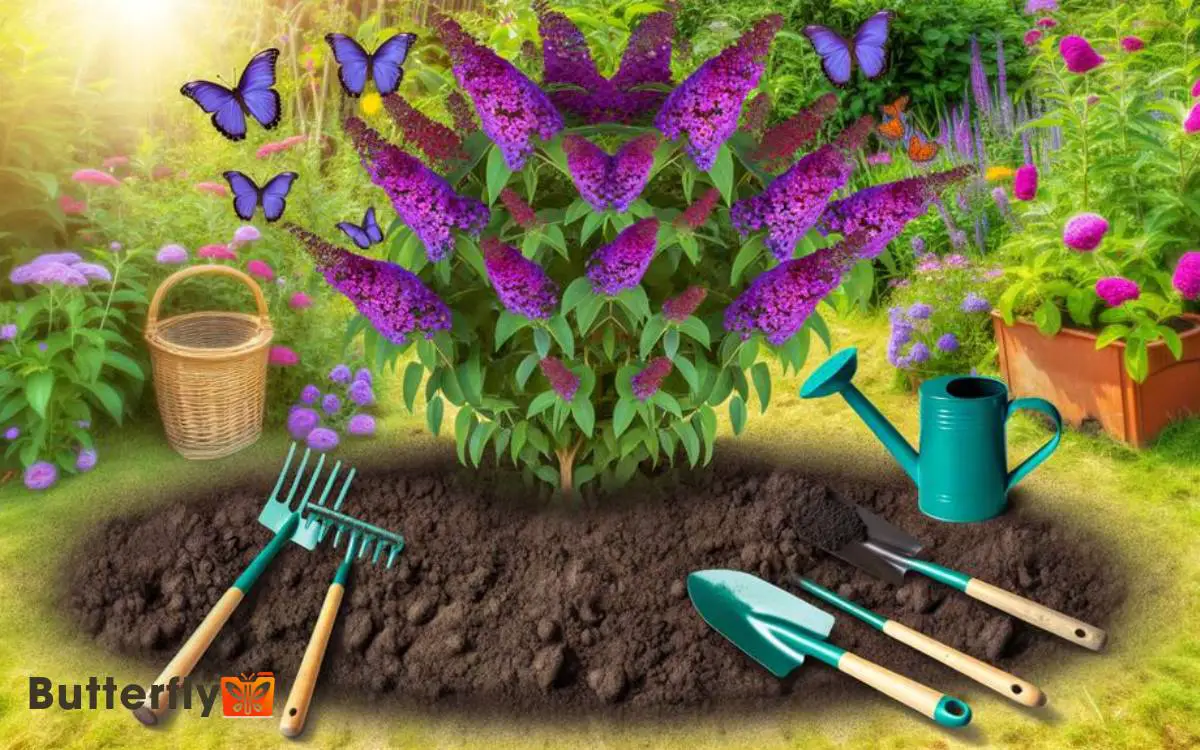Can You Split a Butterfly Bush? Yes!
Yes, you can split a butterfly bush to rejuvenate it and encourage healthy growth. The best times for splitting are in spring or early fall when the plant is either emerging from dormancy or preparing for it.
Preparing the soil with organic matter and monitoring moisture levels is essential for a successful split. Proper care after splitting ensures robust growth and vibrant blooms. Learn important tips and techniques to guarantee success.

Key Takeaways
Understanding Butterfly Bushes
Butterfly bushes, scientifically known as Buddleja, are flowering plants renowned for their ability to attract butterflies and other pollinators.
You’ll find these shrubs in a variety of climates, thriving best in full sun and well-drained soil. They can grow rapidly, reaching heights of up to 10 feet.
The plant produces elongated clusters of small, tubular flowers, available in colors like purple, pink, and white.
It’s important to be aware of their invasive potential in some regions, where they can spread unchecked. Regular pruning helps maintain their shape and encourages blooming.
Additionally, butterfly bushes are relatively drought-tolerant once established, making them a low-maintenance choice for your garden. Understanding these key characteristics will aid you in properly caring for your Buddleja.
Reasons to Split Butterfly Bushes
When your Buddleja becomes too large or crowded, splitting the bush helps promote healthier growth and prevents overcrowding. By dividing the plant, you can improve air circulation, nutrient uptake, and overall vitality.
Here are key reasons to split your butterfly bush:
| Reason | Description |
|---|---|
| Healthier Growth | Reduces competition for nutrients and water |
| Space Management | Prevents overcrowding and maintains garden design |
| Propagation | Creates new plants for other areas or sharing |
| Disease Prevention | Improves air flow, reducing disease susceptibility |
Splitting also allows you to propagate new plants, ensuring you’ve got more butterfly bushes to enhance your landscape or share with others.
Additionally, improved air flow reduces the likelihood of fungal infections, keeping your garden healthier. Splitting is a practical method to maintain your garden’s visual and biological health.
Best Time to Split
Spring or early fall are the best times to split your butterfly bush for maximum health and growth. During these periods, the plant is either emerging from dormancy or preparing for it, thereby minimizing stress.
In spring, the soil is warmer and moisture levels are ideal, promoting root establishment. Early fall splitting allows sufficient time for the roots to establish before winter.
Avoid splitting during the peak growing season or extreme temperature periods, as this can cause undue stress and hinder recovery. Pay attention to weather forecasts; aim for a cool, overcast day to reduce water loss and transplant shock.
Necessary Tools
To guarantee your butterfly bush successfully, gather the necessary tools that will make the process efficient and less stressful for the plant.
You’ll need a sharp spade or shovel to dig around the root ball cleanly. A garden fork is essential for loosening the soil without damaging the roots. Use a sharp knife or pruning shears to cut through the root system accurately.
A clean bucket filled with water helps keep the roots moist during the process. Additionally, having garden gloves will protect your hands. A tarp can be useful to place the dug-up soil and plant parts on, keeping the area tidy.
Make sure all tools are clean and sterilized to prevent disease transmission.
Preparing the Plant
Before you start dividing the butterfly bush, make sure the plant is well-hydrated by watering it thoroughly the day before. This guarantees the roots are flexible and less prone to damage during the division process.
Next, inspect the plant for any diseased or damaged parts. Remove dead or unhealthy branches with sterilized pruning shears to prevent the spread of disease.
You should also cut back the bush to about one-third of its size. This reduces stress on the plant and makes handling easier. Ensure your tools are clean and sharp to make precise cuts.
Digging Up the Bush
To successfully dig up your butterfly bush, choose the proper timing, ideally during early spring or late fall.
- Prepare necessary tools like a spade, garden fork, and pruning shears.
- Handle the root system carefully to minimize damage and guarantee a healthy split.
Choosing Proper Timing
Knowing when to dig up your butterfly bush is crucial for guaranteeing a successful split and healthy regrowth. Aim to dig up the bush in early spring or late fall. During these periods, the plant is either dormant or just beginning to grow, minimizing stress and enhancing recovery.
Avoid mid-summer, as the intense heat can cause undue stress on the plant. Before digging, make sure the soil is moist but not waterlogged.
Moist soil makes the digging process easier and reduces root damage. Monitor weather conditions closely; a calm, overcast day is ideal. This prevents the plant from drying out too quickly.
Necessary Tools Preparation
Acquiring the appropriate tools beforehand guarantees a smooth and efficient process when digging up your butterfly bush.
Start by gathering these essential items:
| Tool | Purpose |
|---|---|
| Spade/Shovel | Dig around and lift the bush |
| Pruning Shears | Trim back foliage for easier handling |
| Garden Fork | Loosen soil and disentangle roots |
A spade or shovel is essential for digging around the bush’s base, allowing you to lift it out of the ground with minimal disturbance. Pruning shears help manage the bush’s size, making it easier to handle.
A garden fork is indispensable for loosening the soil and gently prying apart any tangled roots. These tools make sure you can remove the bush efficiently and prepare it for the next steps.
Root System Handling
Begin by carefully inserting your spade or shovel into the soil about a foot away from the butterfly bush’s base to minimize root damage. Gently work your way around the bush, loosening the soil as you go.
Once you’ve circled the entire plant, start lifting the root ball by applying downward pressure to the spade handle. Be cautious not to snap the roots. If resistance is felt, pause and dig deeper to free more roots.
After freeing the root system, lift the bush from the ground, supporting the root ball with your hands. Inspect the roots for any damage and trim any that are excessively long or broken before proceeding to divide the plant.
Dividing the Root Ball
To divide the root ball of a butterfly bush, use a sharp spade or garden knife to carefully cut through the roots. Make sure your tool is clean to prevent disease transmission.
Position the spade or knife at the center of the root ball and apply steady pressure to create a clean cut. You may need to make several incisions to fully separate the roots.
Examine the divided sections to confirm each has a healthy mix of roots and shoots. Remove any damaged or diseased parts.
Keep the root sections moist during the process to prevent drying out. This careful technique guarantees the divisions have the best chance for successful replanting and growth.
Replanting the Divisions
When replanting the divisions of your butterfly bush, choose a location with full sun and well-drained soil.
- Make sure the new holes are twice as wide and deep as the root balls to promote healthy growth.
- Water the transplanted divisions thoroughly to help them establish in their new environment.
Choosing Optimal Location
Selecting the right location for replanting your butterfly bush divisions is crucial for their successful growth and blooming.
- Choose a spot with full sun, as butterfly bushes thrive in direct sunlight for at least six hours a day. Make sure the area has good drainage to prevent root rot, which can hinder plant health.
- Avoid crowded spaces; give each division enough room to grow, ideally spacing them at least 4 to 6 feet apart. This allows ample air circulation, reducing the risk of disease.
- Consider the mature size of the plant when planning your garden layout.
- Lastly, avoid planting near structures or trees that might cast shadows, ensuring your butterfly bush gets the sunlight it needs for optimal growth and blooming.
Soil and Watering Tips
Securing the thriving of your butterfly bush divisions begins with preparing well-draining soil enriched with organic matter and maintaining consistent, moderate watering. Begin by mixing compost or aged manure into the planting site to enhance nutrient content.
- Monitor soil moisture levels, making sure they remain damp but not waterlogged.
- Maintain soil pH: Aim for a slightly acidic to neutral pH (6.0-7.0).
- Watering frequency: Water newly planted divisions deeply twice a week.
- Mulching: Apply a 2-inch layer of mulch to retain moisture and regulate temperature.
Avoid overwatering, as butterfly bushes are susceptible to root rot. Check soil drainage by digging a small hole and filling it with water; if it drains within 30 minutes, your soil is adequately prepared.
This approach ensures the best growth for your butterfly bush divisions.
Post-Split Care
After splitting your butterfly bush, it’s crucial to water it thoroughly to help establish its roots in the new location. Make sure the soil remains consistently moist but not waterlogged for the first few weeks.
Apply a layer of mulch around the base to retain moisture and regulate soil temperature. Monitor the plant for signs of stress, such as wilting or yellowing leaves, and adjust watering as necessary.
Prune any damaged or excessively long branches to reduce the plant’s energy expenditure on foliage. Fertilize with a balanced, slow-release fertilizer to support healthy growth. Keep an eye out for pests and diseases, treating promptly if necessary.
Common Mistakes
When splitting a butterfly bush, you might encounter common mistakes such as:
- Overwatering young plants
- Using incorrect pruning techniques
- Poor soil preparation
It’s important to avoid these errors to promote healthy growth and vibrant blooms. Let’s address each of these issues to help you achieve the best results.
Overwatering Young Plants
A common mistake with young butterfly bushes is overwatering, which can lead to root rot and stunted growth. It’s important to understand that these plants prefer well-drained soil and moderate watering.
When you overwater, you risk:
- Root Rot: Excess moisture suffocates roots, causing them to decay.
- Stunted Growth: Too much water can prevent nutrients from reaching the plant.
- Fungal Diseases: Damp conditions foster harmful fungi.
To avoid these issues, water your butterfly bush sparingly. Check the soil moisture by inserting your finger about two inches deep; if it feels dry, it’s time to water.
Opt for a watering schedule that allows the topsoil to dry out between sessions. This guarantees healthy growth and prevents common overwatering pitfalls.
Incorrect Pruning Techniques
Just as overwatering can harm your butterfly bush, incorrect pruning techniques can also severely impact its health and growth.
Avoid these common pruning mistakes:
| Mistake | Impact |
|---|---|
| Pruning in Fall | Encourages frost damage |
| Cutting Too Low | Stunts growth, reduces blooms |
| Using Dull Tools | Causes ragged cuts, invites disease |
| Pruning Young Bushes | Weakens plants, delays maturity |
| Ignoring Dead Wood | Attracts pests, encourages decay |
Prune in late winter or early spring, using sharp, sterilized tools. Cut back to healthy buds, and avoid removing more than a third of the plant. By following proper techniques, you’ll promote robust growth and abundant blooms, keeping your butterfly bush vibrant and healthy.
Poor Soil Preparation
Neglecting proper soil preparation can drastically hinder your butterfly bush’s ability to thrive. To guarantee ideal growth, you need to address several key factors.
- First, test the soil pH; butterfly bushes prefer slightly acidic to neutral soil. Aim for a pH between 6.0 and 7.5.
- Next, maintain good drainage to prevent root rot, which can be fatal. Ensure drainage by avoiding waterlogged soil. You can achieve this by adding sand or perlite.
Benefits of Splitting
Splitting a butterfly bush enhances its growth by promoting healthier root systems and increased blooms. When you divide the plant, you give each new section more space to expand, reducing root congestion. This leads to better nutrient absorption and overall plant vigor.
Additionally, splitting can help rejuvenate older bushes that might be struggling to thrive. You’ll also benefit from having multiple plants, which can be strategically placed to attract more pollinators across your garden.
Conclusion
Splitting your butterfly bush might seem challenging, but it’s manageable with the right approach. Remember, it’s not just about propagation; it rejuvenates the plant, promoting vigorous growth and more blooms.
Don’t worry about harming the plant if you follow these steps, it’ll thrive. Use this opportunity to expand your garden or share with friends.
With proper care, your divided butterfly bushes will flourish, rewarding you with vibrant, butterfly-attracting flowers for years to come. Be sure to water the newly divided plants consistently and provide them with plenty of sunlight to encourage healthy growth. As they mature, you may notice various pollinators visiting your garden, drawn by the fragrant blooms. If you’re wondering, are black swallowtails common in Maine, the answer is yes—they are frequently spotted fluttering around gardens, especially where nectar-rich flowers thrive.





